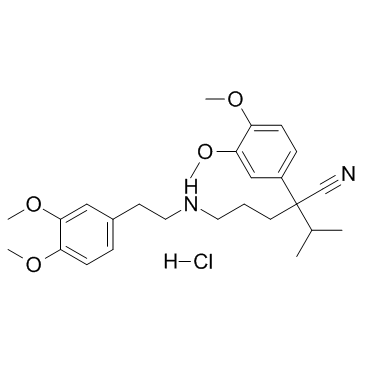Norverapamil hydrochloride

Norverapamil hydrochloride structure
|
Common Name | Norverapamil hydrochloride | ||
|---|---|---|---|---|
| CAS Number | 67812-42-4 | Molecular Weight | 477.04 | |
| Density | N/A | Boiling Point | N/A | |
| Molecular Formula | C26H37ClN2O4 | Melting Point | 155-160℃ dec. | |
| MSDS | Chinese USA | Flash Point | N/A | |
| Symbol |

GHS07 |
Signal Word | Warning | |
|
Verapamil, and its metabolite norverapamil, inhibit macrophage-induced, bacterial efflux pump-mediated tolerance to multiple anti-tubercular drugs.
J. Infect. Dis. 210(3) , 456-66, (2014) Drug tolerance likely represents an important barrier to tuberculosis treatment shortening. We previously implicated the Mycobacterium tuberculosis efflux pump Rv1258c as mediating macrophage-induced tolerance to rifampicin and intracellular growth. In this s... |
|
|
Application of permeability-limited physiologically-based pharmacokinetic models: part II - prediction of P-glycoprotein mediated drug-drug interactions with digoxin.
J. Pharm. Sci. 102(9) , 3161-73, (2013) Digoxin is the recommended substrate for assessment of P-glycoprotein (P-gp)-mediated drug-drug interactions (DDIs) in vivo. The overall aim of our study was to investigate the inhibitory potential of both verapamil and norverapamil on the P-gp-mediated efflu... |
|
|
Stereoselective CZE method for analysis of verapamil and norverapamil in human plasma.
Acta Pol. Pharm. 70(3) , 395-401, (2013) A stereospecific capillary zone electrophoresis (CZE) method was developed for the determination of verapamil (VER) and its main metabolite norverapamil (NOR) in human plasma. Optimal temperature, cyclodextrin selectors (CDs), pH of background electrolyte (BG... |
|
|
Comparative cardiovascular actions of verapamil and its major metabolites in the anaesthetised dog.
Cardiovasc. Res. 12 , 247-254, (1978)
|
|
|
The pharmacology of verapamil. V. Tissue distribution of verapamil and norverapamil in rat and dog.
Pharmacology 27 , 1-8, (1983) The relative distribution of verapamil and its demethylated metabolite, norverapamil, was studied in rats at intervals after intraperitoneal injection of the parent drug (30 mg/kg). This route of drug administration simulated oral drug dosing, and the highest... |
|
|
Physiological pharmacokinetics and pharmacodynamics of (+/-)-verapamil in female rats.
Biopharm. Drug Dispos. 8 , 285, (1987) Tissue distribution and pharmacodynamics of verapamil were evaluated during steady state intravenous (i.v.) infusion and after single dose intraperitoneal (i.p.) drug administration to female Sprague-Dawley rats. In one group of rats, verapamil was infused to... |
|
|
Effects of angiotensin II blockade on inflammation-induced alterations of pharmacokinetics and pharmacodynamics of calcium channel blockers.
Br. J. Pharmacol. 153(1) , 90-9, (2008) Inflammation elevates plasma verapamil concentrations but diminishes pharmacological response. Angiotensin II is a pro-inflammatory mediator. We examined the effect of angiotensin II receptor blockade on the pharmacokinetics and pharmacodynamics of verapamil,... |
|
|
Chiral capillary electrophoretic analysis of verapamil metabolism by cytochrome P450 3A4.
J. Chromatogr. A. 1120(1-2) , 94-101, (2006) Cytochrome P450 (CYP), which is one of the most important enzymes in human liver, is responsible for a large portion of the first-pass metabolism of drugs. Many studies have focused on the determination of CYP activity by substrate assays. Most of them used l... |
|
|
Intravenous fat emulsion therapy for intentional sustained-release verapamil overdose.
Resuscitation 80(5) , 591-3, (2009) We report the first case of sustained-release verapamil toxicity treated with Intralipid fat emulsion (IFE). Toxicity was confirmed by elevated serial serum verapamil and metabolite, norverapamil, levels. Most previously reported cases of IFE therapy involve ... |
|
|
Development of an in vitro rat intestine segmental perfusion model to investigate permeability and predict oral fraction absorbed.
Pharm. Res. 23(7) , 1543-53, (2006) The aims of the study are to develop and evaluate an in vitro rat intestine segmental perfusion model for the prediction of the oral fraction absorbed of compounds and to assess the ability of the model to study intestinal metabolism.The system consisted of a... |